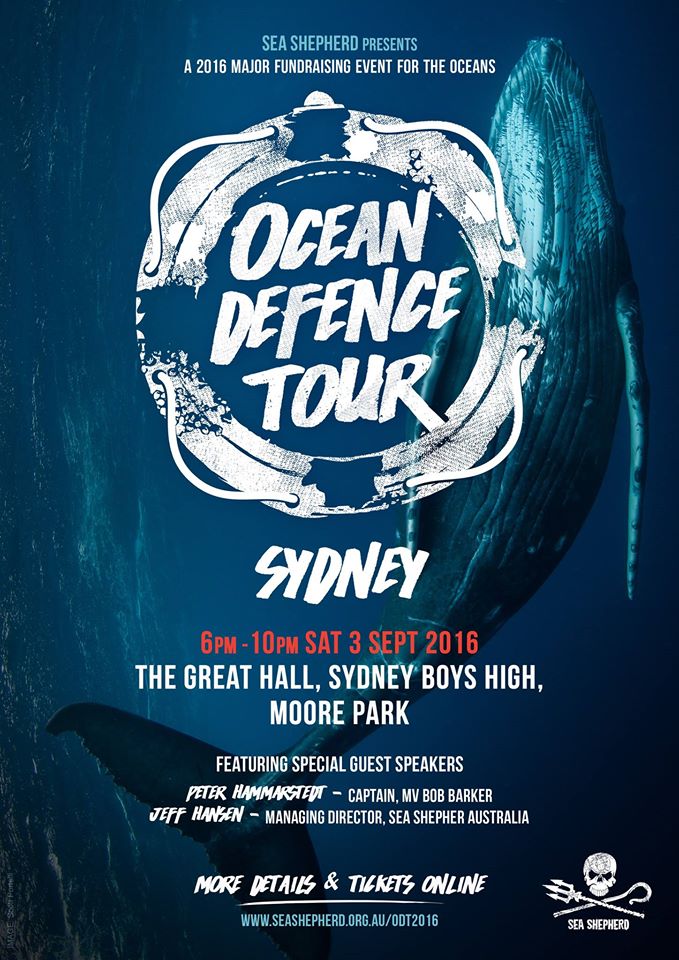August 21 - 27, 2016: Issue 277
Jools Farrell
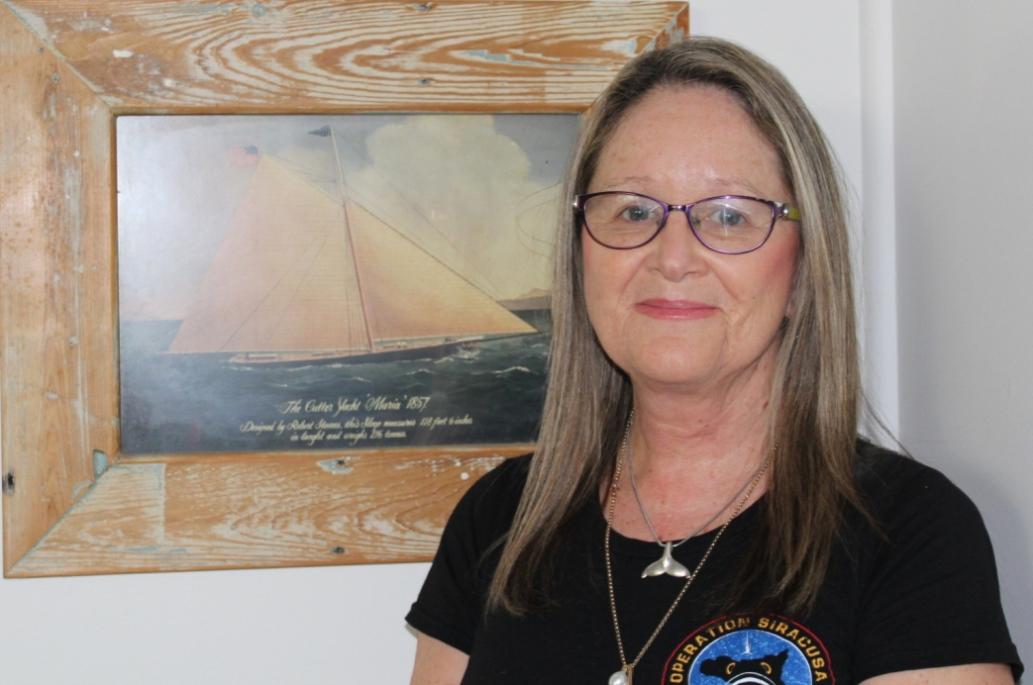
The lead coordinator for the Sydney Chapter of Sea Shepherd began a lifetime of caring for others as one of those that bring every stray animal home as a child. Jools then began a career as a nurse. On retiring a lifelong love of the ocean led her to Sea Shepherd and the opportunity to combine her love of animals and the sea.
A campaign to Antarctica on the SSS Sam Simon as ship's medical officer and quartermaster, helping organise events, fundraisers and raising awareness of what's going on in our oceans has now become a full-time occupation.
Where and when were you born?
I was born at the Mater in Crows Nest, Sydney in 1954.
Where did you grow up?
On the North Shore, at Chatswood. I moved to the Northern Beaches when I started Nursing when I was 17.
What did you do for fun when younger?
We didn’t have computer and laptops then. We’d go bike riding, go for bushwalks. We couldn’t get out of the house quick enough; as soon as the sun was up we’d be outside playing. We would go to the parks, and I loved to go to the beach of course, would have to catch two buses down from Chatswood, it was a lot of effort to get here then.
Which beach were you coming to?
I had a lot of friends at Narrabeen so I used to hang out with the ‘Narra crowd’, as they called us. I moved up to Palm Beach when I stared Nursing.
Did you go into Nursing straight after leaving school?
No, I wanted to do Nursing first off but my dad said ‘you have to go and do a secretarial course, just in case you don’t love Nursing’. He thought I wasn’t going to last six months. In fact, he said, ‘if you last six months I’ll buy you a car’. To the day he died he reckoned I kept at it just to spite him. At any rate, he ended up buying me a brand new Mini Cooper S.
I did 12 months of secretarial work to begin with though, was basically a PA for the General Manager of Holeproof Australia and worked in the city while waiting to start Nursing. This was when you had the old plug switchboards, used typewriters and had to know shorthand.
Where did you do your Nursing?
At Mona Vale Hospital. During that time they would do the training in-house, within the hospitals. I think this is the way it should still be – you were learning on the job, being paid, plus you were working and thus there was n shortage of nurses.
When I did my training you went everywhere in the hospital but I swore that as soon as I finished I was never going to work on a ward again. I went straight into Intensive Care and Accident and Emergency. I’ve done 40 years of A and E Nursing.
I moved to the United States two years after finishing my training. I was only going to stay there for 12 months but ended up staying for five and a half years. I worked in a Trauma Centre in Hawaii for three years there, which was a real eye-opener and incredible training for me.
You always wanted to be a Nurse?
Oh gosh yes, I decided I was going to be a Nurse at age 6. I went in to have my appendix taken out and thought ‘these Nurses are just wonderful people’. From then on I knew I was going to be a Nurse.
What makes a good Nurse?
You’re born a Nurse, if you’re not, you’re not. If you look at some of the girls that come out of the Uni. Courses and Colleges they want to go straight to the top, there’s no understanding of gaining experience through starting at an entry level and learning so you may work your way to the top. They think they know it all from day one and want to go straight into management.
Another aspect about being a good Nurse is having empathy for people, you have to love people, without question. You have that inner something that makes you want to help people. I’m the same with animals as well though. If you have that nature, or character, it extends into other areas.
When did your interest in animals begin?
I was one of these kids that brings home every stray animal. They’d see me coming up the driveway holding something and be ‘what has she found now?!’
My dad was very passionate about animals as well, and I was very close to my dad. As there was only myself and my older sister I was like the son that he never had and a real tomboy. We would do a lot together, into the bush for bushwalks, go fishing. Dad was brought up in Seaforth, one of eleven children. I think I get my love of animals and the sea from him. When I was just starting to crawl my mum and dad and cousins and auntie all went to the beach, either Palm Beach or Mona Vale. On one beach visit they took their eyes off me for a second and then couldn’t see me until my uncle spotted me; I’d crawled all the way down to the water’s edge and was going into the water.
I’ve always loved the ocean but I think when I moved to Palm Beach and was working at Mona Vale Hospital that’s when my love of the ocean grew even more.
Where in Palm Beach were you living?
In a share house, there were six of us, two girls and four guys, on Barrenjoey road. She was a nurse too, we did our Training together. It was opposite where the Greedy Goat is now, a house on stilts which is still there. We lived there for 3 years, had some pretty wild parties, would go down to Pittwater for a swim.
How did you first become involved with Sea Shepherd?
I retired from Nursing, or tried to retire. After 40 years of Intensive Nursing, which is pretty full-on, you see some pretty traumatic things which you won’t forget and get to a point where you need to stop. I thought it was time for me to get out of Nursing and decided to retire.
Mark said, ‘yeah, fine, if you want to retire before you burn out, go ahead’. I soon started to get bored though, you can’t go from full-time Nursing to nothing, there’s only so much gardening you can do. I’m not a ‘ladies lunch’ girl either and don’t play tennis or golf, so I started to get quite bored, was driving Mark nuts. He got to a stage where he told me I had to go and do something. ‘Just go out and get involved in something, you love the ocean, find something’ he said.
I was looking through the Sydney Morning Herald one day and I saw this tiny little notice advertising for people to join the Sydney Chapter, as this didn’t exist then, in 2008. They were looking for people to form this. I went to this meeting in Hyde Park and before I knew it I was one of the original Sydney Chapter volunteers, there was four of us.
In 2010 I was asked to take on the lead Coordinator role. The guy who was the Coordinator started grooming me for this as soon as he met me.
Due to all the work I’d done, and the money I’d raised, I was soon asked to go on a Campaign, and this was my first Southern Ocean Campaign, Operation Zero Tolerance.
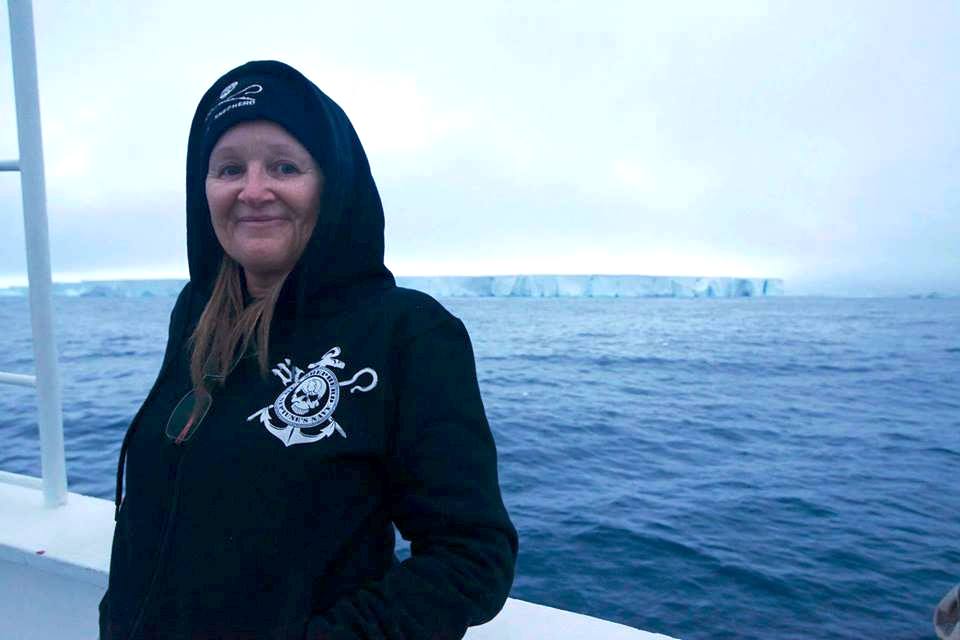
What was that like – what stood out for you, apart from being cold?
The beauty of Antarctica is what hits you immediately, it’s such an absolutely pristine environment.
There was one moment which crystallised so much for me though, one I will never forget.
When we were down in Cooperation Bay, and were getting to go into what I call ‘Battle of the Titans’ or really David & Goliath with SS being David, which is just prior to going into full-on battle with the whaling fleet, were among the ice-floes, penguins around us, seals…and they were on one side of this bay (the whaling fleet), and we were on the other side at about 65 Latitude( and you can only go to about 70 º as it’s very difficult to function, a fair way down there) ... all of a sudden this Humpback whale came out of nowhere and started spy-hopping. It was looking around, came right up to one of our small boats and right near the stern of the Sam Simon, and seemed to be looking around and wondering ‘what the hell is going on here?’.
After it looked around it did the big dive and disappeared, a kind of ‘I’m getting out of here, this isn’t going to be pretty!’.
I was on the Bridge, saw this, and thought, ‘none of us should be here – we shouldn’t be here, they shouldn’t be here – what the hell are we all doing in this sanctuary?!’
We shouldn’t have to be here because the whaling fleet are here to kill whales, what they’re doing is wrong, none of us should be here.
That was a real ‘moment’ for me, it just set or emphasised our purpose there. It just underlined the only reason we were in this beautiful place was because of the whaling fleet.
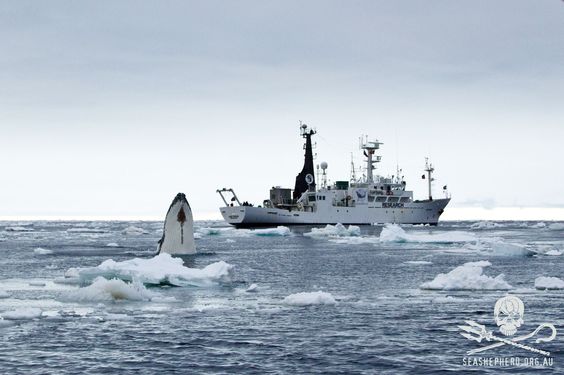
Photo ©Eliza Muirhead.
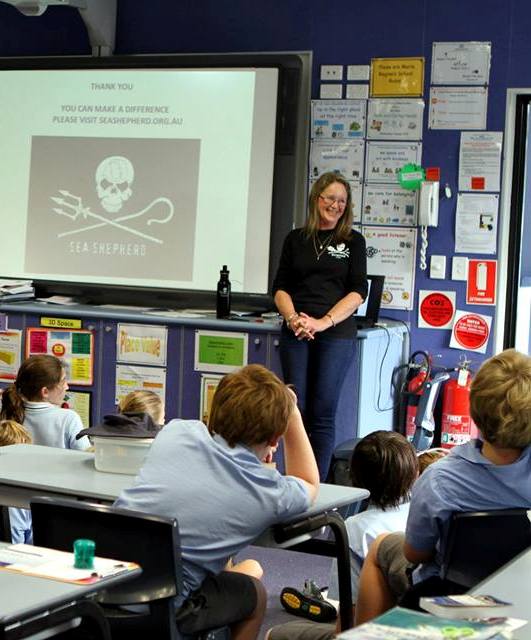 What has happened from there? – every time there’s a Dolphin Day or Whale Days up and down our coast, or a campaign to not have plastics in the ocean, or the whale data study going on off Pittwater, you seem to be there…Has this become a full-time job for you?
What has happened from there? – every time there’s a Dolphin Day or Whale Days up and down our coast, or a campaign to not have plastics in the ocean, or the whale data study going on off Pittwater, you seem to be there…Has this become a full-time job for you?It has, this now takes up three quarters of my life each week. I run the Sea Shepherd Facebook page where we’re trying to share news through the Sydney Chapter, make people aware this is all going on now, wherever something is happening around the world. I do training for the new volunteers as well and run the Chapter. I do have 4 co-coordinators and a 2IC but it still takes up a lot of hours each week.
Public speaking is now part of what I do, speaking in schools to bring awareness of what is happening and what people can do. That’s what Sea Shepherd is about, making people aware of what is going on right now.
People may not know how sick the ocean is, that it’s in jeopardy. Some may not know that we need the ocean, this is where the bulk of the oxygen we breathe comes from. The amount of plastics in the ocean is just outrageous. The nets that are causing so much damage to everything that lives in the ocean; only a day ago, and almost daily throughout the whale migration season you see and hear about baby whales being caught in shark nets. Although they have taken a lot of these out in some places in Queensland because of the annual migration there are still incidences of whales getting caught in them – they should all just be taken out, completely. The point is, if you don’t want to encounter something that lives in the ocean, don’t go in there – swim in a pool!
The amount of over-fishing taking place through trawlers being allowed to still keep ‘harvesting’, that’s the term they use ‘harvest’. These trawlers ‘harvesting’ not only catches birds and other aquatic animals such as seals and dolphins, it’s also a form of drag-netting that completely destroys the floor of the ocean, ruining that environment for everything that lived there.
What’s involved in training a volunteer?
When people go to the website, www.seashepherd.org.au, there’s a link for ‘Get Involved’ (www.seashepherd.org/get-involved) – and there’s onshore and offshore for this. They just click on there and fill out the form, or they can send us an email to sydney@seashepherd.org.au and we’ll send them out the paperwork to join.
The paperwork goes to the head office and gets processed and then we at Sydney get the paperwork saying ‘you’ve got a new volunteer’.
We send them a Welcome Letter and then we begin training. This can start with them being put into a Merchandise Stall where they buddy up with a volunteer that’s been doing these stalls for a while. We also have Training Days where we go through what Sea Shepherd is about. Added to this is what to do at a Merchandise stall, about how to conduct yourself as part of Sea Shepherd: behaviour, we talk about reaching out to people, the whole gamut of what’s involved and what they can do.
What’s the difference between an onshore role and an offshore role?
If it wasn’t for the onshore work done by volunteers we wouldn’t be able to do the offshore Campaigns that we do – this is where the money to fund these come from. This is a vital role for anyone to undertake, the funding comes from the onshore volunteers working on the Merchandise stalls, or standing on a street corner shaking a tin raises funds but it’s also getting the word out that something is happening that needs to be addressed. Onshore people work really hard but they all state they get a lot of satisfaction out of it and many don’t want to go to sea, don’t want to be on a ship for three months, they want to support the work from being ‘onshore’.
There’s a lot of hard work for the onshore people involved, for a person placed in charge of a Merchandise stall, as one example, there’s a lot of paperwork – we have a Captain placed in charge of each who takes care of the stall and takes care of the volunteers as well.
You were recently in Europe, an offshore role example – what was that about?
I was really fortunate to be invited to be part of that. The beauty of Operation Siracusa was that it was a fundraising trip as well as a Campaign. The first leg of this was purely raising awareness and fundraising. We went to Bremen, Antwerp, France for the Cannes Film Festival, Italy, Sicily. Part of the reason for going to Cannes was focusing attention on a dolphinarium in Antibes, two train stops down from Cannes, where an Orca died last year during severe flooding; they left this orca there in this filthy tank and it died as a result.
Sea Shepherd had a Press Conference while there this year. Pamela Anderson, Alex Cornelissen and Paul Watson attended to direct attention on this facility and the mortality rate within its confines. Sea Shepherd is totally opposed to keeping all animals in captivity.
This was the main reason we were at Cannes. Paul also wanted us all to be seen, so to speak, to simply be there to, once again, raise awareness. We arrived a week early and parked the ship right out the front of where the Cannes Film Festival was taking place so every time someone is beinginterviewed there’s the Sam Simon in the background.
The other part of Operation Siracusa 2016, which was the third consecutive campaign to tackle poaching and illegal fishing in the Plemmirio Marine Reserve on the east coast of Syracuse, Sicily (Italy). Led by Sea Shepherd Italia, Sea Shepherd volunteers work in collaboration with the Italian Coast Guard and onshore authorities to ensure law enforcement, to document poaching activities, and focus to media attention on the devastating consequences of poaching on the marine environment in the region. This is about the Plemmirio Marine Reserve, established in 2004 and classified as a Specially Protected Area of Mediterranean Interest. The region is of great importance because of its delicate ecosystem and extraordinary wildlife, which includes tuna, amberjacks, dolphins, sharks, Sperm whales.
People are not ignorant that a dolphin, shark or whale will live for decades longer in the ocean than it will in these facilities – why are they still open, as marine hospitals?
Money, it all comes down to money. The Cove, Taiji, which starts on the 1st of September each year, is a standout example of this – this is where dolphins come from. The dolphins people see in aquariums, every time a person pays money to go and see these, they are perpetuating this.
The Taiji fishermen that slaughter these dolphins and also take dolphins to be placed in captivity, will get up to $300, 000 for one dolphin.
If you look closely into this you will see it’s the Bottlenose dolphins that they’re after. If they get a pod of Pilot whales normally they’ll slaughter the lot. If they see one that’s pretty, they’ll keep it, but it’s the Bottlenose that they’ll take as these are the most acrobatic. These are the ones that are sold to places like Sea World and also the Middle East – there’s a huge market there now too for this and they are buying dolphins from Taiji. People don’t realise that this is where these dolphins are coming from, they think they’ve been born and bred within these facilities or that they’ve been rescued and nursed back to health. A percentage of these have been rescued and should have been rehabilitated and released, but they’re not, they’re kept.
So it’s all about money. Every time you go to an aquarium you’re perpetuating what happens in Taiji. I say to people, watch The Cove, think about it.
The Great Australian Bight, Operation Jeedara, what’s that about?
Sea Shepherd Australia is part of the Fight for the Bight Alliance, whose mission is to stop BP from drilling for oil in the Great Australian Bight. BP wish to place oil rigs there. The Gulf of Mexico is still trying to recover and will never recover from the oil disaster that occurred there in April 2010, the Deepwater Horizon Oil Spill on the BP-operated Macondo Prospect. Everything in the water and all those people whose livelihoods were dependant on this are gone.
If you look at the weather patterns that occur in the Great Australian Bight you quickly see that these are ten times worse than those that frequent the Mexico Gulf. The Great Australian Bight is home to a whale shark nursery, it’s a Blue Whale highway, Southern Right Whales calve here, it’s home to loggerhead turtles, seal colonies, the wildlife there is just beautiful and this is a pristine environment.
If BP are allowed to drill there it’s not just the ocean that will be affected it’s all the land around it, places like Ceduna where plans to put in railways and an airport are currently being discussed.
Do you fear there will be an oil spill on the scale of that which occurred in the Gulf of Mexico?
Of course; it’s not a matter of ‘if’ but ‘when’. This is why the SSS Steve Irwin is there now.
We ran a Campaign in the Kimberly region where the Steve Irwin went up to James Price Point and were fortunate to be able to support the people there opposed to this ill-thought out plane. We won, they withdrew due to our presence there.
The Steve Irwin has gone to the Great Australian Bight with Bob Brown, Bunna Lawrie and Jeff Hansen aboard to raise awareness of how beautiful this area is and how we cannot allow this to be placed in jeopardy by allowing BP to come in there.
Also, if there is an issue, we don’t have the equipment here in Australia to deal with it, it would have to come in from overseas and by that time the damage will have been done, they will have destroyed that environment, irreversibly.
The Campaigns are expensive to run – where does the funding come from?
Donations from the public. To get the money for Operation Jeedara we had to run a crowd funding awareness campaign which has been really successful, fortunately. We had to raise $150, 000 minimum for this campaign and people quickly helped us reach that target – this gives you some idea of how passionate people are about protecting our oceans.
The cost of running these campaigns gives you an insight into how expensive it can be to save environments and all that live in them. It normally costs around 4 million to go down to the Southern Ocean, to send our ships down there; there’s the fuel, food, etc.
Where do the ships come from?
In Australia we have the Steve Irwin, that’s our flagship. The Steve Irwin was an ex-Scottish coast guard ship. The SSS Bob Barker was actually an ex-Norwegian whaling vessel. So, for the bad it did it’s actually doing good now in the case of that ship.
The SSS Brigitte Bardot, our scout boat, doesn’t go the Southern Ocean anymore as she’s carbon fibre and not built for that range or those waters. She’s named after Brigitte Bardot in honour of the French fashion model, actress, and singer whom Paul Watson, the founder of Sea Shepherd, took on an anti-sealing trip in 1977. *
Before becoming the Brigitte Bardot this vessel set a World Record as the Cable and Wireless Adventurer by circumnavigating the world in less than 80 days (accomplished in July 1998 in 74 days, 20 hours, 58 minutes, traveling more than 22,600 nautical miles (41,855 km).
The SSS Sam Simon is named after Sam Simon as he gave us the money to purchase that. This was an ex-Japanese Oceanographic research vessel that assisted the Japanese whaling fleet with the northern whaling. This vessel was actually moored with the whaling fleet when Sea Shepherd went undercover to purchase it. They even delivered it to Cairns for us, unaware who the purchaser was. I was one of the original crew members on that ship.
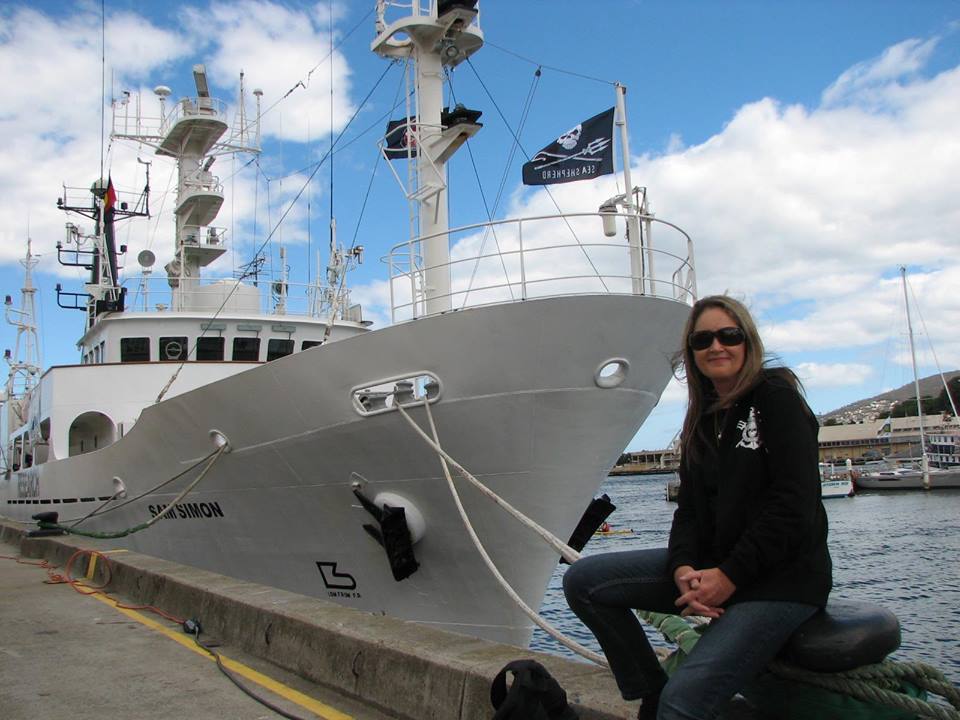
Jools with the SSS Sam Simon
Does the Japanese person on the street wish to purchase whale meat?
No, the majority of people don’t. This is again money related, and lately, this hasn’t added up. They have to get 70% of their quota to remain ‘licensed’. We’ve been going down there for 10 years now and for the last six or seven years they haven’t reached that quota.
I also think you could also ascribe the perpetuation of this whaling to a Japanese cultural ‘saving face’. We thought with the International Court (ICJ) ruling against whaling this would give them a way to bow out gracefully. For some reason this has been interpreted as them having to bow out to Sea Shepherd, despite everyone else who doesn’t want this happening anymore, and so they have continued, now breaking the law because of pride.
I think the majority of people in Japan don’t want this. They had three really big protests in Tokyo in 2015 about whaling and The Cove and animals kept in captivity but are persisting anyway.
The IWC have refused their permit and so this fleet could now be termed ‘rogue’ in going to Antarctica to slaughter whales. The ICJ (International Criminal Court) has stated they’re not doing scientific research, they don’t have one skerrick of evidence, which they don’t, but are still going to slaughter whales.
Who polices this then?
It should be the Australian Government – they should be there stating ‘you are commercially whaling in a whale sanctuary’. They’re going into our waters and New Zealand waters to do this. The New Zealand and the Australian government are not doing anything though. Malcolm Turnbull, when he met with the Japanese Prime Minister, stated he was ‘disappointed’.
That’s all he said.
It’s money, the Free Trade Agreement, we can’t be seen to be upsetting Japan.
There’s a fundraiser for the Sydney Chapter of Sea Shepherd coming up, The Ocean Defence Tour – who’s speaking this year?
Captain Peter Hammarstedt will be speaking this year, the Captain of the Bob Barker. He’s an amazing speaker and has taken on a lot of the speaking roles since Paul Watson was arrested in 2012, had a Red Notice placed on him by Interpol later that year, and cannot travel now to speak ****. Normally he (Paul) would attend and speak at our fundraisers, but not this year.
Peter is passionate about what he does, loves to meet people, so it will still be a great evening.
Jeff Hansen, the Managing Director for Sea Shepherd Australia will also be speaking. Jeff is currently at The Great Australian Bight as part of Operation Jeedara.
Added to this we’ll have some excellent music in local musician James Lange, who is finishing off a great new album, and Peter Calvert, a triple j unearthed musician who is exceptionally good as well.
There will also be some great food being done by the lovely Megan Brown, a great vegan chef. Megan will be doing some tasty canapés, the canapés and non alcoholic drinks are included in the ticket price. Wine and beer will be on offer too for purchase – these have been donated as an extra way to raise funds on the evening.
Silent Auction items will also be available for people who attend to bid on – there’s some great things there such as a weekend away at Merimbula Beach cabins, whale watching trips, a real ship’s flag signed by Paul Watson, as well as t-shirts signed by him, hampers, all sorts of great stuff. I'm currently sharing these on the Sea Shepherd Sydney facebook page: www.facebook.com/SeaShepherdSydneyofficial/
There will also be information stalls on all the Campaigns such as the Marine Debris in the ocean or the shark campaign, Apex Harmony.
Tickets ($10: Children – $35: Adult) at: www.eventbrite.com.au/e/sea-shepherd-ocean-defence-tour-sydney-tickets
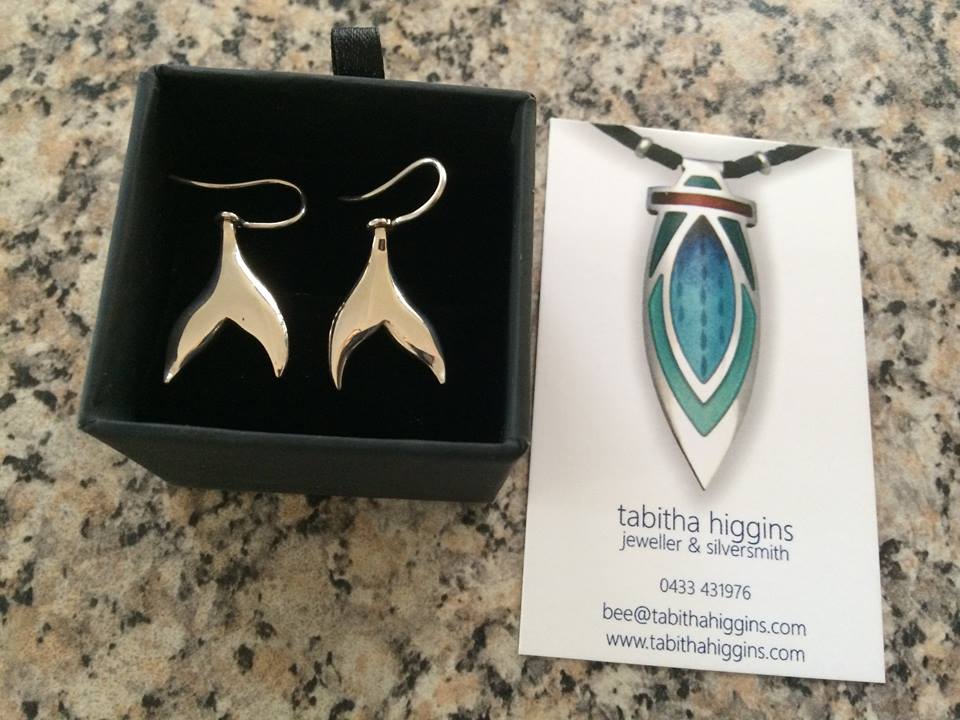
Local artist Tabitha Higgins silent auction item.
How did you meet Mark?
I met Mark 27 years ago, he’s another one who’s been on the water all his life.
Unfortunately my first husband passed away, a really traumatic experience.
A girlfriend of mine was living with a bunch of people at Bungan Beach and asked me to come down and spend the weekend with them. Mark was living down the South Coast and used to come up every other weekend and happened to be visiting that weekend. We still reckon she set us up but to this day she swears she didn’t.
As soon as we met we got on like a house on fire. When he left he invited me to visit him down the South Coast. A few weeks later I did go and it started from there. Eventually we took a place at Narrabeen.
The Reliance, who found her?
Mark. He had always wanted to have a classic like her. He’d been following her on Trade Boat for ages but the previous owner wanted too much for her. Finally he told me and we went and saw it, I saw how beautiful she was and we made an offer and she’s now ours. We’ve had her for seven years now.
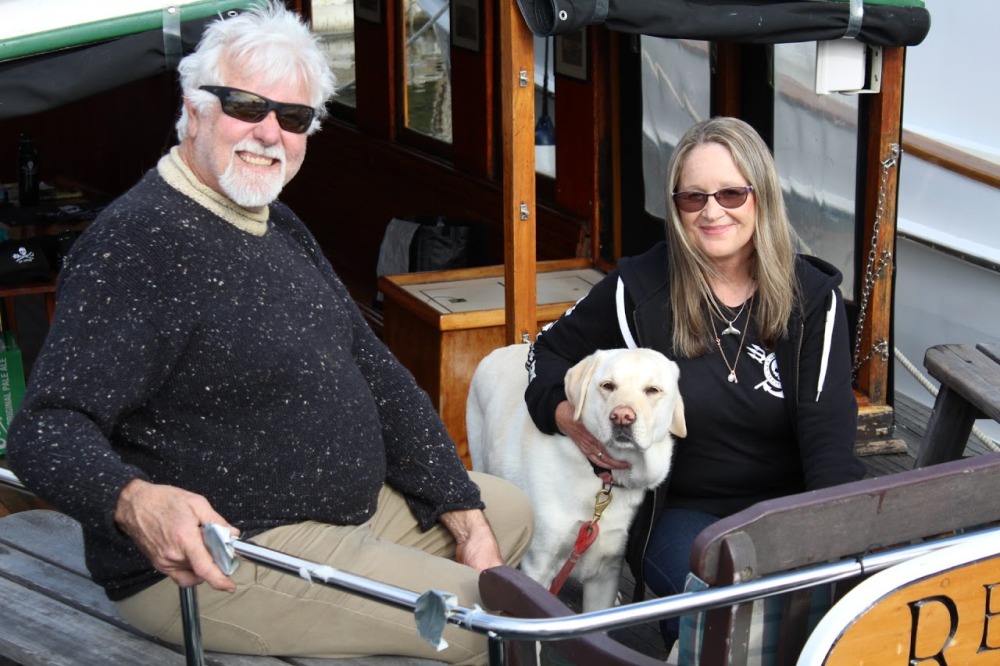
Mark, Tess and Jools Farrelll
What would you like to see happen in the future for our oceans, both locally and world wide?
I’d like to see a dramatic reduction of plastics in the ocean to begin with. I think what Boomerang Bags are doing is awesome. A reduction in commercial fishing is equal with that, the super trawler, The Geelong Star that’s actually fishing off our East Coast as we speak has killed 9 dolphins, seals and a whale shark and they are still trawling. Everywhere they go they’re destroying that marine environment – dragnet fishing kills everything in its wake, it destroys the seabed, has a massive by-catch problem. Commercial fishermen are also over-fishing the ocean, this has got to be stopped.
And of course I want to see whaling ceased – I want to see Japan, Norway and Finland stop slaughtering whales. Finland takes the endangered Fin whales. Just recently they slaughtered 80 Fin whales and most of this goes into dog food because Japan wouldn’t take the whale meat from them.
Japan have to be stopped coming into the southern ocean and whaling. They’re commercially whaling in a whale sanctuary – ‘sanctuary’ means ‘safe haven’. This is where our beautiful whales that are going up and down the coast here at the moment, that’s where they’re going, they’re taking their young back to a whale sanctuary. It’s Minkes, that also migrate up, that the Japanese are now targeting.
I’d love to see Taiji shut down, this is the most brutal, unconscionable instance of everything that is wrong in continuing to slaughter these animals.
My birthday is on the 31st of August and Taiji starts on the 1st of September, so I never look forward to my birthday because I know that Taiji starts the next day. That goes on for six months. Every day I’m watching, checking; is it a Blue Cove day or a Red Cove day – have they got a hunt going on, have they driven another pod, a family, into this cove to kill them. There are Cove Guardians there but I couldn’t do that. Going to Antarctica is different, you’re actually taking action, you’re getting in the way, whereas Cove Guardians, at Taiji, it’s in their waters, there’s nothing you can do. All these people can do is stand there and bear witness, get the word out by live streaming it around the world and making people aware of the atrocities happening there.
The Faeroes is another example of this; a slaughter of Pilot whales is happening as we speak as well. This is brutal, again, and they don’t even eat the meat, this is a boyhood to manhood tradition. There’s a big graveyard in the Faeroes where Sea Shepherd divers have recorded the skeletons, piles of them.
These brutal practices are arcane, any culture must have grown beyond seeing this as an acceptable way to conduct a society – why do this?
Basically I’d like to see the oceans left alone – BP in the Bight, plastics killing the oceans and all in them, what’s been done to the Great Barrier Reef – people need to realise if they don’t take action, don’t speak up these places will die. The oceans aren’t infinite, they’re finite and although we may not see them die in our lifetime, the next generation will if we don’t do and continue to do something now. We will see a dead ocean and then a dead planet if we don’t. We cannot survive without the ocean.
But I’d also like to see people keep their hands off the bush as well of course. Homo sapiens are now a disease on this planet, we’re killing our own planet, which is pretty sad. So this brings us back to awareness, that’s why I do what I do, to make people aware.
What are your favourite places in Pittwater and why?
I love Towlers Bay, Morning Bay, Lovett Bay, Clareville. Last Sunday we spent the day on a yacht and went round to Refuge Cove and Americas Bay. The Hawkesbury is right up there too, Lion Island, I love it all. When you’re on the water, looking at all the different colours of sandstone, or being able to see nothing but trees because we have Ku-ring-gai National Park on our doorstep. This is just a magic place to be, it changes all the time.
Avalon Beach, Miss Tessa and I walk there every day.
What is your ‘motto for life’ or a favourite phrase you try to live by?
Respect the oceans. Basically, please respect the oceans.
Also, Do unto others as you would have them do unto you.
That’s a phrase that I go by a lot. My dad used to say that a lot.
Don’t Take It For Granted is part of that too of course – Live Each Day to the Fullest.
